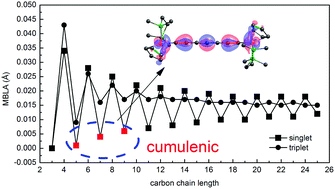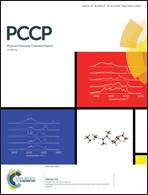Most favorable cumulenic structures in iron-capped linear carbon chains are short singlet odd-carbon dications: a theoretical view†
Abstract
Iron-capped, linear-carbon-chain dications have been investigated at the M06L/DZP level of quantum chemistry in order to determine their structural and electronic properties, focusing on differences between chains containing odd and even numbers of carbon atoms. Such differences result from changes in the electronic states and the acetylenic or cumulenic nature of the carbon chain. Interestingly, the short even-carbon chains exhibit distinct properties, but upon chain lengthening undergo a transition to structures similar to those of odd-carbon chains, with a turning point around [FeC10Fe]2+. On the other hand, the less extensively investigated short odd-carbon chains, such as [FeC5Fe]2+, [FeC7Fe]2+ and [FeC9Fe]2+, due to synthetic difficulty, are predicted to exhibit more exceptional properties than the short even-carbon chains in every aspect, such as excellent back bonding as well as more cumulenic and more nearly linear structures. This theoretical study suggests that more experimental work should be considered on metal-capped, short linear odd-carbon chains as potential building blocks for novel electronic and optical materials.



 Please wait while we load your content...
Please wait while we load your content...